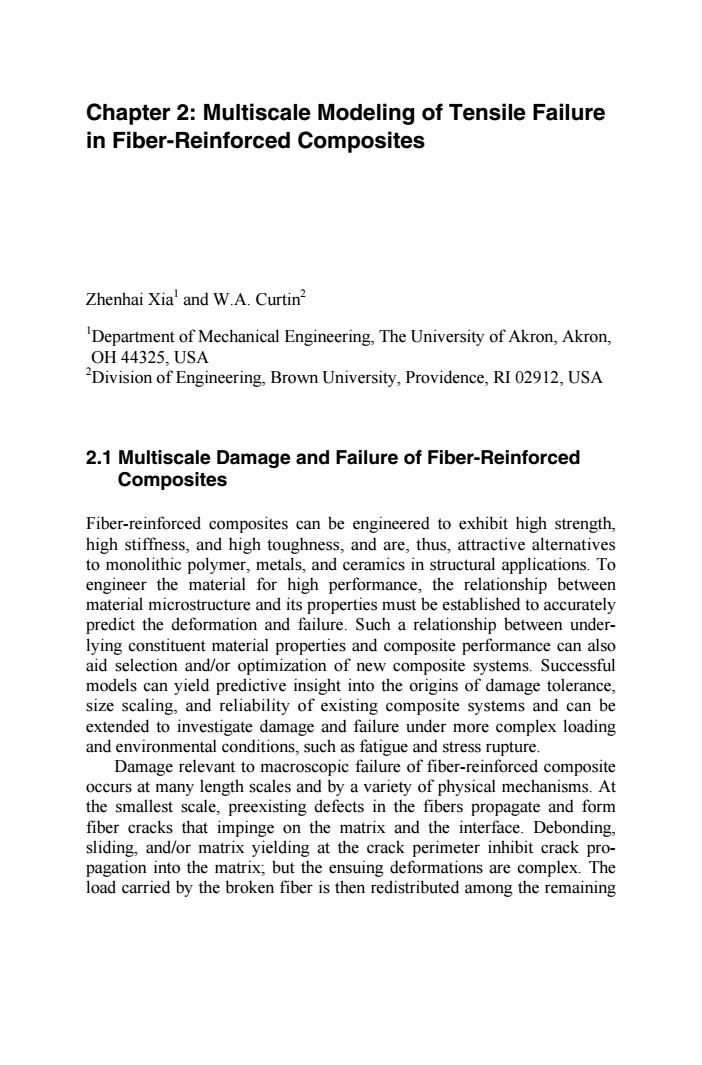正在加载图片...

Chapter 2:Multiscale Modeling of Tensile Failure in Fiber-Reinforced Composites Zhenhai Xia'and W.A.Curtin2 'Department of Mechanical Engineering,The University of Akron,Akron, OH 44325,USA PDivision of Engineering,Brown University,Providence,RI 02912,USA 2.1 Multiscale Damage and Failure of Fiber-Reinforced Composites Fiber-reinforced composites can be engineered to exhibit high strength high stiffness,and high toughness,and are,thus,attractive alternatives to monolithic polymer,metals,and ceramics in structural applications.To engineer the material for high performance,the relationship between material microstructure and its properties must be established to accurately predict the deformation and failure.Such a relationship between under- lying constituent material properties and composite performance can also aid selection and/or optimization of new composite systems.Successful models can yield predictive insight into the origins of damage tolerance, size scaling,and reliability of existing composite systems and can be extended to investigate damage and failure under more complex loading and environmental conditions,such as fatigue and stress rupture. Damage relevant to macroscopic failure of fiber-reinforced composite occurs at many length scales and by a variety of physical mechanisms.At the smallest scale,preexisting defects in the fibers propagate and form fiber cracks that impinge on the matrix and the interface.Debonding, sliding,and/or matrix yielding at the crack perimeter inhibit crack pro- pagation into the matrix;but the ensuing deformations are complex.The load carried by the broken fiber is then redistributed among the remainingChapter 2: Multiscale Modeling of Tensile Failure in Fiber-Reinforced Composites Zhenhai Xia1 and W.A. Curtin2 1 Department of Mechanical Engineering, The University of Akron, Akron, OH 44325, USA 2 Division of Engineering, Brown University, Providence, RI 02912, USA 2.1 Multiscale Damage and Failure of Fiber-Reinforced Composites Fiber-reinforced composites can be engineered to exhibit high strength, high stiffness, and high toughness, and are, thus, attractive alternatives to monolithic polymer, metals, and ceramics in structural applications. To engineer the material for high performance, the relationship between material microstructure and its properties must be established to accurately predict the deformation and failure. Such a relationship between underlying constituent material properties and composite performance can also aid selection and/or optimization of new composite systems. Successful models can yield predictive insight into the origins of damage tolerance, size scaling, and reliability of existing composite systems and can be extended to investigate damage and failure under more complex loading and environmental conditions, such as fatigue and stress rupture. Damage relevant to macroscopic failure of fiber-reinforced composite occurs at many length scales and by a variety of physical mechanisms. At the smallest scale, preexisting defects in the fibers propagate and form fiber cracks that impinge on the matrix and the interface. Debonding, sliding, and/or matrix yielding at the crack perimeter inhibit crack propagation into the matrix; but the ensuing deformations are complex. The load carried by the broken fiber is then redistributed among the remaining